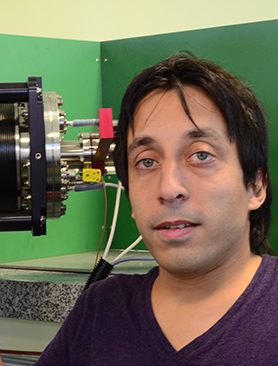( UNDAV-CONICET )

Topic: Resistive switching in binary and graphene oxides
Metal oxide metal structures show an abrupt change in resistance when subjected to electrical pulses (memristive effect). This change can be volatile or not, giving effect to a device that can act as a non-volatile memory or as an artificial synapse, encoding its resistance level in logical states or as the synaptic weight (memristor). Recently, the possibilities and advantages of using the synaptic behavior of memrisors in artificial neural networks have been widely demonstrated, from simple learning rules to recognition of live images with multilayer perceptrons [1]. In this work we show that the combination of the mechanisms of drift and diffusion of oxygen vacancies in conjunction with charge trapping allows to select analog or digital and excitatory or inhibitory behaviors, and finally volatile or non-volatile regime in our artificial synapses.
For this, structures of Al/TiO2 /Au and Si/SiO2/Ti/HfO2/Co were nano fabricated by means of sputtering, evaporation and atomic layer deposition (ALD) with intermediate lithography steps. Electrical pulses above the dielectric breakdown voltage were applied in order to activate the synaptic behavior. Through the sub- and supra-threshold pulses of voltage and / or current, the different modes of behavior were selected [2].
In Al/TiO2/Au devices, digital and analog synaptic functionality was demonstrated with voltage pulses above and below the threshold voltage. In addition, the inhibitory or excitatory synaptic modes with current pulses of different dI/dV’s were selected.
In the Si/SiO2/Ti/HfO2/Co devices, the volatile and non-volatile regimes of the artificial synapse were studied by means of the control of the compliance current (Icc). For currents below 100 nA a volatile regime was obtained where the threshold voltages decrease with increasing Icc. When the electrical current was not limited, a non-volatile regime was obtained with a ratio between the low and high resistance states of 106 [3 ].
References
[1] S.J. Lee, et al., J. Neurosci. 16 (2016) 2768.
[2] Ghenzi. N y Levy. P, Microelectronic Engineering, 193 (2018) 13.
[3] Quinteros, C. et al., Journal of Applied Physics 115 (2014) 24501.
Summary Background
Nestor Ghenzi was born in Buenos Aires, Argentina, in 1984. He received the B.E. degree in physics from the Balseiro Institute (IB), Rio Negro, Argentina, in 2007, and the M.Tech. and Ph.D. degrees in physics from the Sabato Institute (IS) Buenos Aires, Argentina, in 2009 and 2014, respectively.
In 2015, he joined the nanodevices group in Nanogune institute, as a Lecturer. Since March 2016, he has been with the Department of Condensed Matter group, CAC-CNEA, where he was an Assistant Professor. In 2019 he moved to the Photonic group of UNDAV where he leads the artificial intelligence group for signal processing and pattern recognition in distributed fiber optic sensors. His current research interests include nano electronics, memristors, nano-engineered fiber optic and distributed sensors.
Dr. Ghenzi is a Fellow of the National Scientific and Technical Research Council, Argentina. Dr Ghenzi has over 30 publications and pending patents in the field of memristors and distributed fiber optic sensors. He was the recipient of the MIT Research Prize in 2014, and the nano Mercosur Award for his contributions to the field of nano electronics in 2015.
